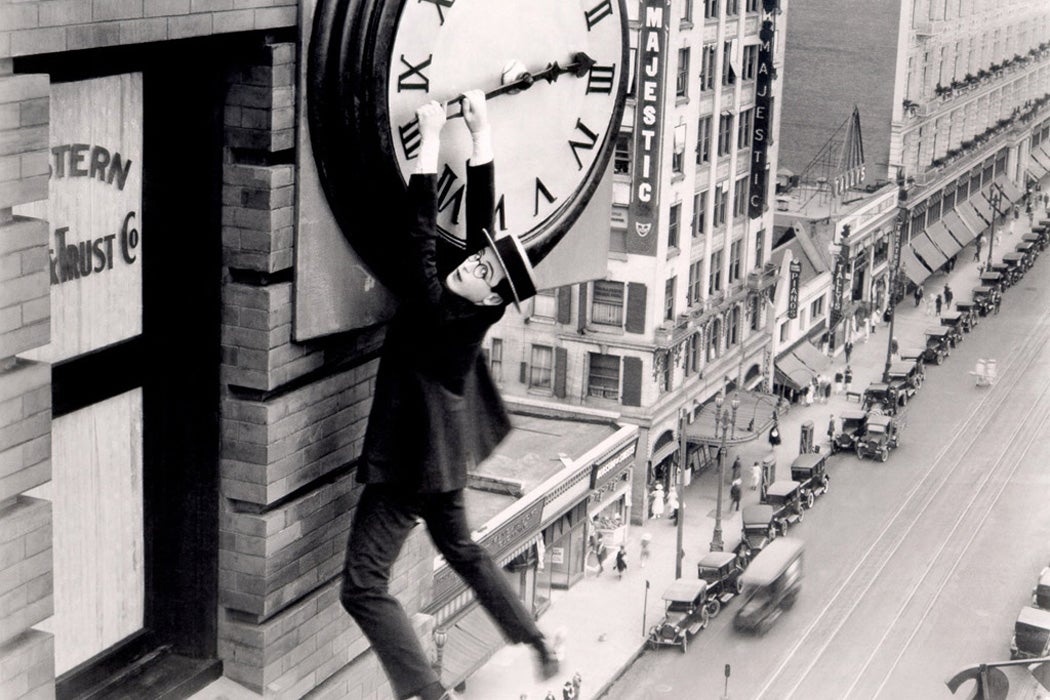For most of its runtime, Never Weaken is a sweet, silly, and darkly comic story about a lovesick young man trying to make a living in the city. But around the 20-minute mark, this silent short movie takes a turn. As the blindfolded hero sits in his office chair, preparing to fire the gun he’s pointed at his heart, a wayward steel beam from a construction site slips into the open window, scooping up his chair and carrying him outside. As he dangles several stories above the bustling city streets, the man transforms into an unlikely trapeze artist. He climbs onto an incomplete building and attempts to make his way down, even as ladders disappear and the foundation shifts around him.
The sequence is funny, but it’s also stressful. It’s the kind of thing you’d expect Tom Cruise to do in a Mission Impossible movie (if he had slapstick sensibilities). It was exactly the type of set-piece audiences expected from Harold Lloyd, a prolific silent film star of the 1920s known for his exhilarating stunts. Sometimes he straddled a streetcar, other times he clung to skyscrapers. By juxtaposing extraordinary gags with an utterly ordinary screen persona, Lloyd made ludicrously difficult tasks seem achievable. The contrast infused his carnivalesque movies with an everyman quality and a boundless optimism, which arguably made him the most universal comedian of his day.
Lloyd began his movie career as an extra, first appearing in bit roles for The Edison Company and Universal Studios in the early 1910s. At the latter studio, he met the legendary producer and director Hal Roach, who was, at the time, just another extra like Lloyd. Once he moved behind the camera, Roach began casting his colleague in comedic shorts. Lloyd’s first attempt at a trademark character was Lonesome Luke, a somewhat formless personality that borrowed from Charlie Chaplin’s Little Tramp. The mustachioed character anchored roughly 100 shorts before Lloyd unveiled his more original, enduring “Glasses” persona.

“Glasses” was a go-getter. He wore a suit and tie, a flat straw boater hat, and a pair of round glasses. This character didn’t pull strange faces or constantly slip on the sidewalk; he held down a job and usually tried to win over a woman. “[He] could be your nextdoor neighbor,” Lloyd said in an interview with the scholar Arthur B. Friedman. “He was just a young man who wore glasses. He kind of thought a little out of the normal group, though.”
This slight difference was crucial, since it took an unusual logic to solve the unusual problems he encountered. “In a great many of the stories that we devised, it looked like he never had a chance to succeed or he couldn’t overcome what appeared to be insurmountable obstacles,” Lloyd continued. “But he had great concentration and determination; and regardless of how hopeless a situation looked, he just seemed to keep going ahead and succeeded in the end.”
“Glasses” comedy centered on universal problems. Maybe he needed to make more money, or maybe his crush hadn’t noticed him. He would approach the issue with confidence and purpose, only for it to spiral into something much bigger—and much stranger. “With comedy, trouble is one of the greatest ingredients because there are so many variations to it,” Lloyd mused. “You take the newspapers. What is mainly printed in newspapers? Grief and trouble… I think they do that because people somehow get a feeling—well, they are all right now. Someone else is in trouble and everyone has enough complexities in life. It makes them feel a little better if somebody else is having difficulties, too.”
The formula is perfectly illustrated in Safety Last!, Lloyd’s most famous movie. In the 1923 feature, Lloyd’s hero (simply credited as “The Boy”) leaves his hometown to start a career in the city. His plan is to quickly climb the corporate ladder, so he can afford to marry his fiancée (“The Girl”) and move her out to the city as well. He gets a job as a department store clerk, but insinuates in his letters home that he’s landed a much more impressive position. Believing he’s already amassed a fortune, The Girl takes a train to join him.
Weekly Newsletter
In a desperate panic to earn extra money, he hatches a scheme with his roommate Bill, who has a talent for scaling buildings. If Bill climbs the exterior of the department store to drum up publicity, The Boy can cash out $1,000 from upper management. When the day arrives, Bill has to flee the scene due to ongoing issues with the police. As the cop chases him, Bill tells his friend to start the stunt—they can switch spots after he reaches the first story. But, of course, it doesn’t go that way. The cop is so persistent that The Boy has to climb the entire building, eventually dangling from the hands of the clock at the top of the store. It’s a heart-stopping image that implies imminent disaster.
The movie ends not with a splat, but with a kiss. He’s managed to scale a building, impress his boss, and keep his fiancée—all without breaking any bones. Naturally, the scene required some movie magic. In this case, the film crew relied on stunt doubles, a facade set, and skewed camera angles. Lloyd sold the illusion with his own dogged determination. The actor starred in an estimated 300+ films over the course of his career, making more movies than Charlie Chaplin and Buster Keaton combined. In that way, he was like the characters he created—a tireless worker who took on any challenge with a smile, and just a little flailing.
Watch the movie for free, via our friends at the Public Domain Review.







